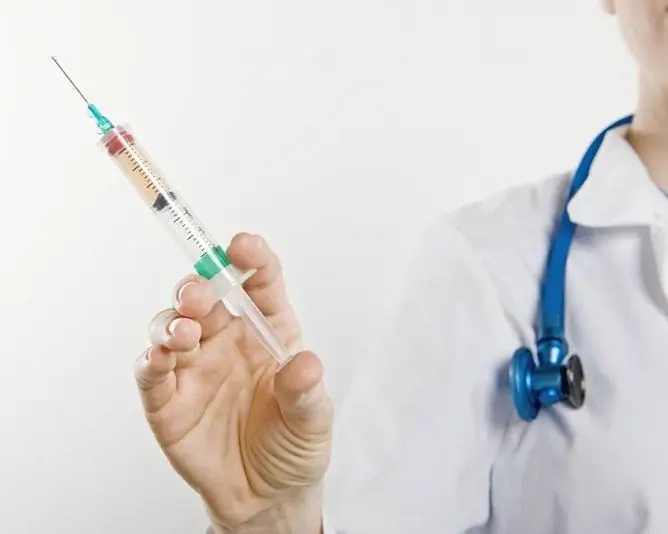- Author Rachel Wainwright [email protected].
- Public 2023-12-15 07:39.
- Last modified 2025-11-02 20:14.
Triaxon
Triaxon: instructions for use and reviews
- 1. Release form and composition
- 2. Pharmacological properties
- 3. Indications for use
- 4. Contraindications
- 5. Method of application and dosage
- 6. Side effects
- 7. Overdose
- 8. Special instructions
- 9. Application during pregnancy and lactation
- 10. Use in childhood
- 11. In case of impaired renal function
- 12. For violations of liver function
- 13. Drug interactions
- 14. Analogs
- 15. Terms and conditions of storage
- 16. Terms of dispensing from pharmacies
- 17. Reviews
- 18. Price in pharmacies
Latin name: Triaxone
ATX code: J01DD04
Active ingredient: ceftriaxone (Ceftriaxone)
Manufacturer: Aurobindo Pharma Ltd. (Aurobindo Pharma Ltd.) (India)
Description and photo update: 2020-20-02

Triaxone is a cephalosporin antibiotic for parenteral use.
Release form and composition
The drug is produced in the form of a powder for the preparation of a solution for intravenous (i / v) and intramuscular (i / m) administration: crystalline, white or white with a yellow-orange tint (0.25; 0.5 or 1 g in a transparent vial glass, sealed with a rubber stopper, crimped with an aluminum cap, and a closed plastic lid; in a cardboard box 1 or 5 bottles and instructions for the use of Triaxon, in a cardboard box 20 or 50 bottles).
1 bottle with the drug contains sodium salt of ceftriaxone in the amount of 0.25; 0.5 or 1 g (based on dry matter).
Pharmacological properties
Pharmacodynamics
Ceftriaxone is a broad-spectrum antibiotic cephalosporin of the third generation for parenteral administration. The active substance exhibits a bactericidal effect, blocks the synthesis of the cell membrane, in vitro inhibits the growth of a large number of gram-positive and gram-negative bacteria. Demonstrates resistance to β-lactamases (penicillinase and cephalosporinase produced by most gram-positive and gram-negative microorganisms).
In vitro and in real clinical practice, Triaxone, as a rule, has bactericidal activity against the following microbes:
- gram-positive: Streptococcus pneumoniae, Streptococcus V (Str.agalactiae), Streptococcus bovis, Streptococcus viridans, Streptococcus A (Str.pyogenes), Staphylococcus epidermidis, Staphylococcus aureus; methicillin-resistant Staphylococcus spp. shows resistance to cephalosporins, including ceftriaxone; also resistant to Triaxon most strains of enterococci (Streptococcus faecalis);
- gram negative: Escherichia coli, Enterobacter spp. (some strains are immune), Branhamella catarrhalis, Alcaligenes spp., Aeromonas spp., Citrobacter spp., Haemophilus influenzae, Haemophilus ducreyi, Haemophilus parainfluenzae, Klebsiella spp. (including Kl. pneumoniae), Neisseria meningitidis, Neisseria gonorrhoeae, Morganella morganii, Moraxella spp., Proteus vulgaris, Proteus mirabilis, Providencia spp., Plesiomonas shigelloides, Pseudomonas aeruginosa (some strains of spp.) (including S. marcescens), Shigella spp., Salmonella spp. (including S. typhi), Yersinia spp. (including Y. enterocolitica), Vibrio spp. (including V. cholerae); many strains of the above microorganisms that multiply stably in the presence of antibiotics such as penicillins, first generation cephalosporins and aminoglycosides,are sensitive to ceftriaxone; in vitro and in experiments on animals, it was established that Treponema pallidum is susceptible to ceftriaxone; according to clinical data, Triaxon demonstrates high efficiency in primary and secondary syphilis;
- anaerobes: Clostridium spp. (including CI. difficile), Bacteroides spp. (including individual strains of B. fragilis), Fusobacterium spp. (except for F. varium, F. mostiferum), Peptostreptococcus spp., Peptococcus spp.; individual strains of many Bacteroides spp. (B. fragilis), producing β-lactamase, are immune to ceftriaxone; to establish sensitivity, it is necessary to use discs containing ceftriaxone, since it is known that some strains of pathogens in vitro may be resistant to classical cephalosporins.
Pharmacokinetics
With parenteral use of Triaxone, the active substance penetrates well into body fluids and tissues. In healthy adults, the half-life (T 1/2) of the drug is approximately 8 hours. The values of the area under the concentration-time curve (AUC) in the serum for intravenous and intramuscular administration are the same, that is, when m the introduction of Triaxone injections, the bioavailability of ceftriaxone is 100%. When used intravenously, the substance quickly penetrates into the interstitial fluid and retains its bactericidal activity against pathogens sensitive to it for 24 hours.
In newborns under the age of 8 days and in elderly patients over 75 years of age, the average T 1/2 of the drug is approximately 2 times higher than that in healthy adult volunteers. Under the influence of the intestinal flora, the main substance is converted into an inactive metabolite.
In adults, 50-60% of ceftriaxone is excreted in unchanged form in the urine, and 40-50% in the bile. In newborns, an average of 70% of the administered dose is eliminated by the kidneys. In adults with functional disorders of the liver or kidneys, the pharmacokinetics of ceftriaxone practically does not change, and T 1/2 increases slightly. In case of impaired renal function, the elimination of the drug with bile increases, and in case of liver pathology - with urine.
Ceftriaxone is characterized by reversible binding to albumin. In this case, the degree of this binding is inversely proportional to the level of the active substance, for example, when its serum concentration in the blood is less than 100 mg / l, it binds to proteins by 95%, and at a concentration of 300 mg / l - only 85%. As a result of the lower content of albumin in the interstitial fluid, the level of ceftriaxone in it exceeds that in the serum.
In children, including newborns, with inflammation of the meninges, ceftriaxone penetrates into the cerebrospinal fluid. Against the background of bacterial meningitis, approximately 17% of the serum concentration of the drug diffuses into the cerebrospinal fluid, which is approximately 4 times more than in the case of aseptic meningitis. 24 hours after intravenous administration of the drug at a dose of 50-100 mg / kg, its content in the cerebrospinal fluid exceeds 1.4 mg / l. 2-25 hours after administration at a dose of 50 mg / kg in patients with adult meningitis, the content of ceftriaxone was many times higher than the minimum inhibitory dose required to inhibit the microorganisms that cause meningitis most often.
Indications for use
Triaxone is recommended for use in the treatment of infections caused by pathogens sensitive to ceftriaxone:
- meningitis;
- respiratory tract infections, especially pneumonia, and infections of the ENT organs;
- infections of the abdominal cavity - diseases of the biliary tract and gastrointestinal tract (GIT) of an inflammatory nature, peritonitis;
- sepsis;
- kidney and urinary tract infections;
- genital infections, including gonorrhea;
- infections of joints, bones, skin, connective tissue;
- infectious lesions in patients with weakened immunity.
Also, the antibiotic Triaxon is indicated to prevent the development of infections in the postoperative period.
Contraindications
- I trimester of pregnancy, lactation period;
- hypersensitivity to cephalosporins and penicillins.
Triaxon, instructions for use: method and dosage
The solution prepared from the drug is administered intravenously or intramuscularly.
Recommended daily doses of Triaxone (frequency of administration 1 time per day):
- adults and adolescents over 12 years of age: 1000-2000 mg of ceftriaxone every 24 hours; in serious cases or with infections caused by moderately sensitive pathogenic microorganisms, the dose may be increased to 4000 mg;
- newborns under the age of 14 days: 20-50 mg / kg; due to the immaturity of the enzyme system of newborns, the dose of 50 mg / kg should not be exceeded;
- children under 12 years of age, including newborns at the age of 14 days: 20-75 mg / kg; with a body weight of 50 kg and more, the doses recommended for adults are used; doses exceeding 50 mg / kg must be administered as an intravenous infusion for at least 30 minutes.
The course of treatment is established depending on the course of the disease.
It has been experimentally established that synergism can be observed between ceftriaxone and aminoglycosides in terms of the effect on most gram-negative bacteria. It is impossible to predict the potentiated effect of such combined use in advance, however, against the background of severe and life-threatening infections (including those caused by Pseudomonas aeruginosa), their combined use is justified. But since ceftriaxone is physically incompatible with aminoglycosides, these agents must be used separately in the prescribed doses!
Recommended courses of treatment depending on the indications:
- bacterial meningitis: in children, including newborns, once a day at an initial dose of 100 mg / kg; the maximum daily dose is 4000 mg, immediately after the identification of the pathogen and the establishment of its susceptibility to Triaxon, the dose should be reduced accordingly; the duration of therapy, in which the best results were recorded in the treatment of the disease caused by Neisseria meningitides, was 4 days, Haemophilus influenzae - 6 days, Streptococcus pneumoniae - 7 days, sensitive Enterobacteriaceae - 10-14 days;
- gonorrhea, excited by strains producing and not producing penicillinase: once in a dose of 250 mg i / m;
- prevention of infections in the pre- and postoperative period: 30-90 minutes before surgery, once in a dose of 1000 to 2000 mg, depending on the degree of risk of infection.
In the case of a combination of severe renal and hepatic impairment, it is necessary to regularly monitor the serum concentration of ceftriaxone in the blood.
Methods for preparing and using the solution:
- i / m introduction: the drug in a dose of 1000 mg is diluted in 3.5 ml of 1% lidocaine solution, i / m Triaxon injections are injected deep into the gluteus muscle; a solution containing lidocaine is not allowed to be administered intravenously;
- IV injection: Triaxone at a dose of 1000 mg is diluted in 10 ml of sterile distilled water, injected IV slowly over 2-4 minutes;
- IV infusion: Triaxone at a dose of 2000 mg is dissolved in approximately 40 ml of a calcium ion-free infusion solution such as 0.9% sodium chloride solution; sodium chloride solution 0.45% containing 2.5% glucose; glucose solution 5%; glucose solution 10%; fructose solution 5%; dextran solution 6%; the duration of the intravenous infusion should be at least 30 minutes.
Side effects
- digestive system: stomatitis, glossitis, diarrhea, nausea, vomiting; rarely - a transient increase in the activity of hepatic transaminases, hepatitis, cholestatic jaundice; extremely rare - pseudomembranous colitis;
- hematopoietic system: changes in the peripheral blood picture - neutropenia, thrombocytopenia, leukopenia, eosinophilia, hemolytic anemia;
- urinary system: oliguria, interstitial nephritis;
- nervous system: dizziness, headaches;
- dermatological reactions: itching, skin rash, urticaria, allergic dermatitis, mycoses in the genital area, erythema multiforme; rarely - Quincke's edema;
- allergic reactions: anaphylaxis, anaphylactic reactions;
- others: chills, increased serum creatinine levels;
- local reactions: after intravenous administration - phlebitis (to prevent this undesirable effect, the solution should be injected within 2-4 minutes); after i / m injections - soreness at the injection site.
The above-described side effects of Triaxone, as a rule, disappear after stopping the course of treatment.
Overdose
In case of an overdose of the drug, symptomatic therapy is recommended. Excessively high plasma ceftriaxone levels cannot be reduced by hemodialysis or peritoneal dialysis.
special instructions
During the period of use of Triaxone, even with a detailed history taking, there is a likelihood of anaphylactic shock, with the development of which an immediate appropriate therapy is required (intravenous adrenaline, glucocorticoids).
In some cases, an ultrasound examination (ultrasound) of the gallbladder detects the presence of a shadow, indicating the deposition of precipitation. This symptom disappears after completion of therapy or temporary refusal to administer Triaxone. Even with the existing pain syndrome, such changes are eliminated by conservative therapy and do not require surgical intervention.
With long-term treatment, periodic monitoring of the blood count is recommended.
The antibiotic Triaxone should only be used in a hospital setting.
Application during pregnancy and lactation
In pregnant women, adequate and well-controlled studies of the safety of Triaxone have not been conducted.
It is contraindicated to use the drug in the first trimester of pregnancy, in the second and third trimesters it can be used only if the expected benefit of treatment for a woman exceeds the possible threat to the fetus.
It has been established that ceftriaxone in low concentrations is excreted in breast milk, therefore, if Triaxone therapy is necessary during lactation, breastfeeding should not be continued.
Pediatric use
According to in vitro studies, ceftriaxone can displace bilirubin associated with serum albumin, therefore, in newborns with hyperbilirubinemia, especially in premature infants, Triaxone should be used only under strict medical supervision.
With impaired renal function
In patients with functional impairment of the kidneys against the background of normal liver activity, it is not required to reduce the dose of Triaxone. However, in patients with renal insufficiency in the preterminal stage (with creatinine clearance below 10 ml / min), the maximum daily dose of the drug should not exceed 2000 mg.
Patients receiving hemodialysis treatment do not need to change the dose of ceftriaxone after this procedure.
For violations of liver function
In patients with functional impairment of the liver, provided there is no failure of renal function, there is no need to adjust the dose of Triaxone.
Drug interactions
- other antibiotics: Triaxone should not be mixed in the same infusion bottle or syringe with these agents due to chemical incompatibility;
- sulfinpyrazone, non-steroidal anti-inflammatory drugs (NSAIDs), salicylates (drugs that reduce platelet aggregation): the threat of bleeding is aggravated, since ceftriaxone, inhibiting the intestinal flora, blocks the synthesis of vitamin K;
- loop diuretics: the risk of nephrotoxicity increases;
- anticoagulants: the therapeutic effect of these drugs increases.
Analogs
Triaxone analogs are Ceftriaxone, Tornaxon, Torocef, Stericsef, Medaxon, Lendacin, Rocefin, Intrasef, Movigip, Lifaxon, etc.
Terms and conditions of storage
Store in a place out of the reach of children, protected from light penetration, at a temperature not exceeding 25 ° C.
Shelf life is 2 years.
Terms of dispensing from pharmacies
Dispensed by prescription.
Reviews about Triaxone
There are currently no reviews of Triaxon on specialized sites, so it is not possible to objectively assess its effectiveness and disadvantages.
Price for Triaxon in pharmacies
The price of Triaxone is unknown, since the antibiotic is currently not available in the pharmacy network. The price for an analogue of the drug, Ceftriaxone, in the form of a powder for the preparation of a solution for intravenous and intramuscular administration, can be 18-34 rubles. for 1 bottle containing 1 g.

Anna Kozlova Medical journalist About the author
Education: Rostov State Medical University, specialty "General Medicine".
Information about the drug is generalized, provided for informational purposes only and does not replace the official instructions. Self-medication is hazardous to health!






